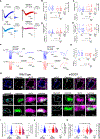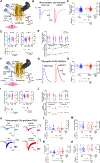Spinal microcircuits go through multiphasic homeostatic compensations in a mouse model of motoneuron degeneration
- PMID: 39656589
- PMCID: PMC11847574
- DOI: 10.1016/j.celrep.2024.115046
Spinal microcircuits go through multiphasic homeostatic compensations in a mouse model of motoneuron degeneration
Abstract
In many neurological conditions, early-stage neural circuit adaptation preserves relatively normal behavior. In some diseases, spinal motoneurons progressively degenerate yet movement remains initially preserved. This study investigates whether these neurons and associated microcircuits adapt in a mouse model of progressive motoneuron degeneration. Using a combination of in vitro and in vivo electrophysiology and super-resolution microscopy, we find that, early in the disease, neurotransmission in a key pre-motor circuit, the recurrent inhibition mediated by Renshaw cells, is reduced by half due to impaired quantal size associated with decreased glycine receptor density. This impairment is specific and not a widespread feature of spinal inhibitory circuits. Furthermore, it recovers at later stages of disease. Additionally, an increased probability of release from proprioceptive afferents leads to increased monosynaptic excitation of motoneurons. We reveal that, in this motoneuron degenerative condition, spinal microcircuits undergo specific multiphasic homeostatic compensations that may contribute to preservation of force output.
Keywords: ALS; CP: Cell biology; CP: Neuroscience; Renshaw cells; electrophysiology; glycine receptors; motoneurons; motor control; quantal analysis; sensory afferents; spinal cord.
Copyright © 2024 The Author(s). Published by Elsevier Inc. All rights reserved.
Conflict of interest statement
Declaration of interests R.M.B. is a co-founder, is on the board of Sania Therapeutics Inc., and consults for Sania Rx Ltd.
Figures







Update of
-
Spinal microcircuits go through multiphasic homeostatic compensations in a mouse model of motoneuron degeneration.bioRxiv [Preprint]. 2024 Oct 12:2024.04.10.588918. doi: 10.1101/2024.04.10.588918. bioRxiv. 2024. Update in: Cell Rep. 2024 Dec 24;43(12):115046. doi: 10.1016/j.celrep.2024.115046. PMID: 38645210 Free PMC article. Updated. Preprint.
References
-
- Lees AJ (1991). Ageing and Parkinson’s Disease: Substantia Nigra Regional Selectivity. Brain, A J. Neurol 114, 2283–2301. - PubMed
Publication types
MeSH terms
Substances
Grants and funding
LinkOut - more resources
Full Text Sources
Molecular Biology Databases
Miscellaneous

